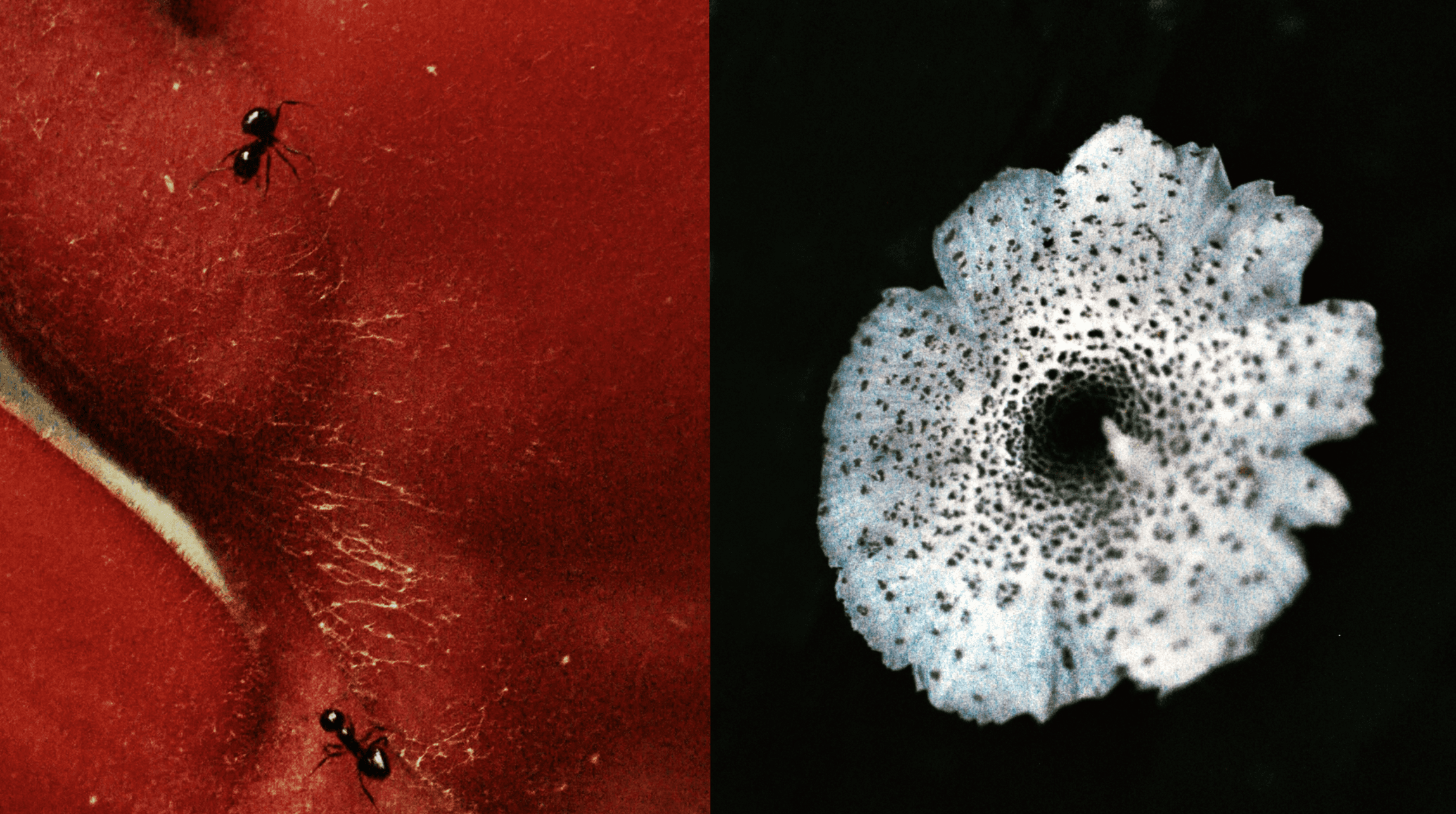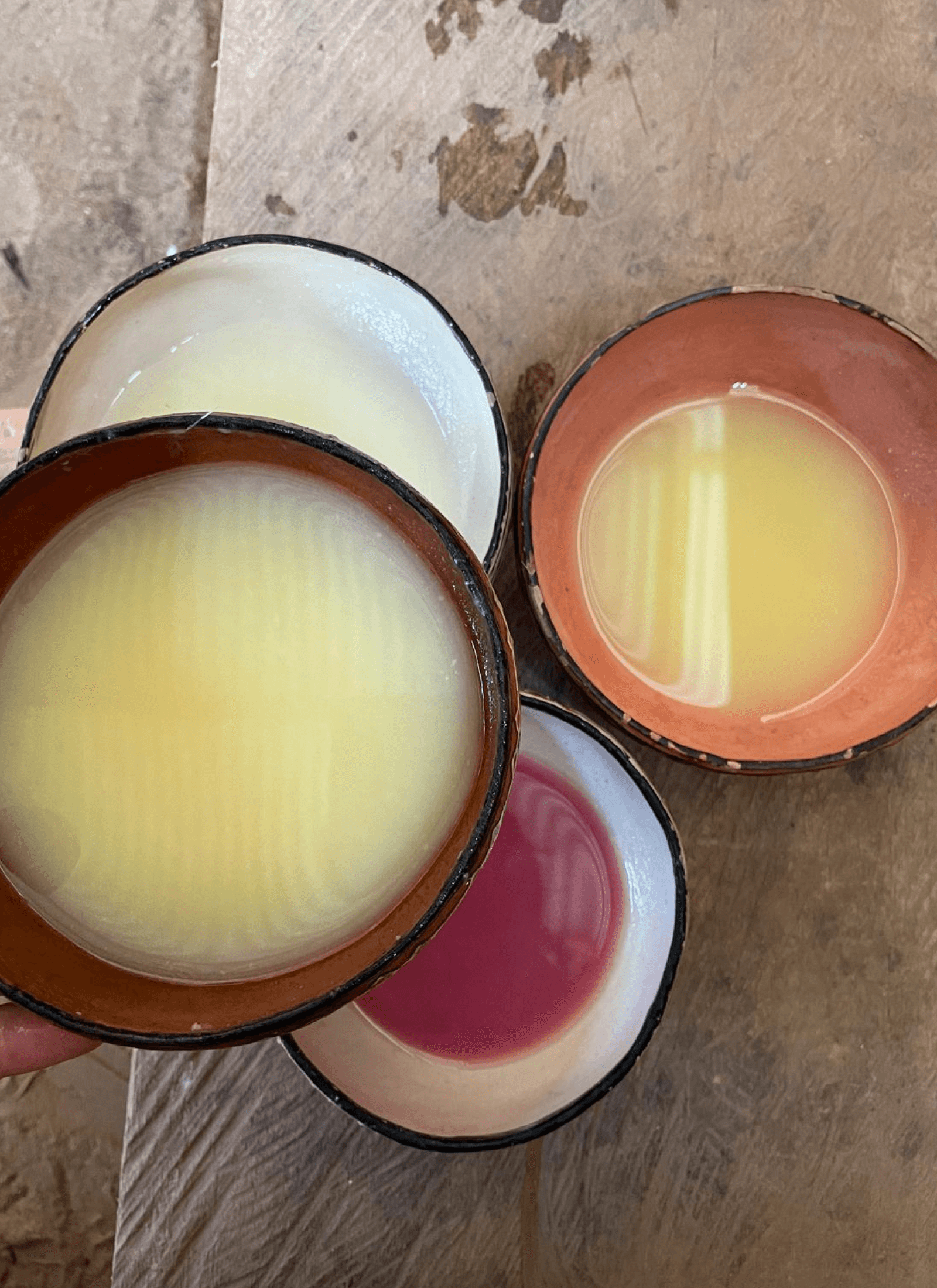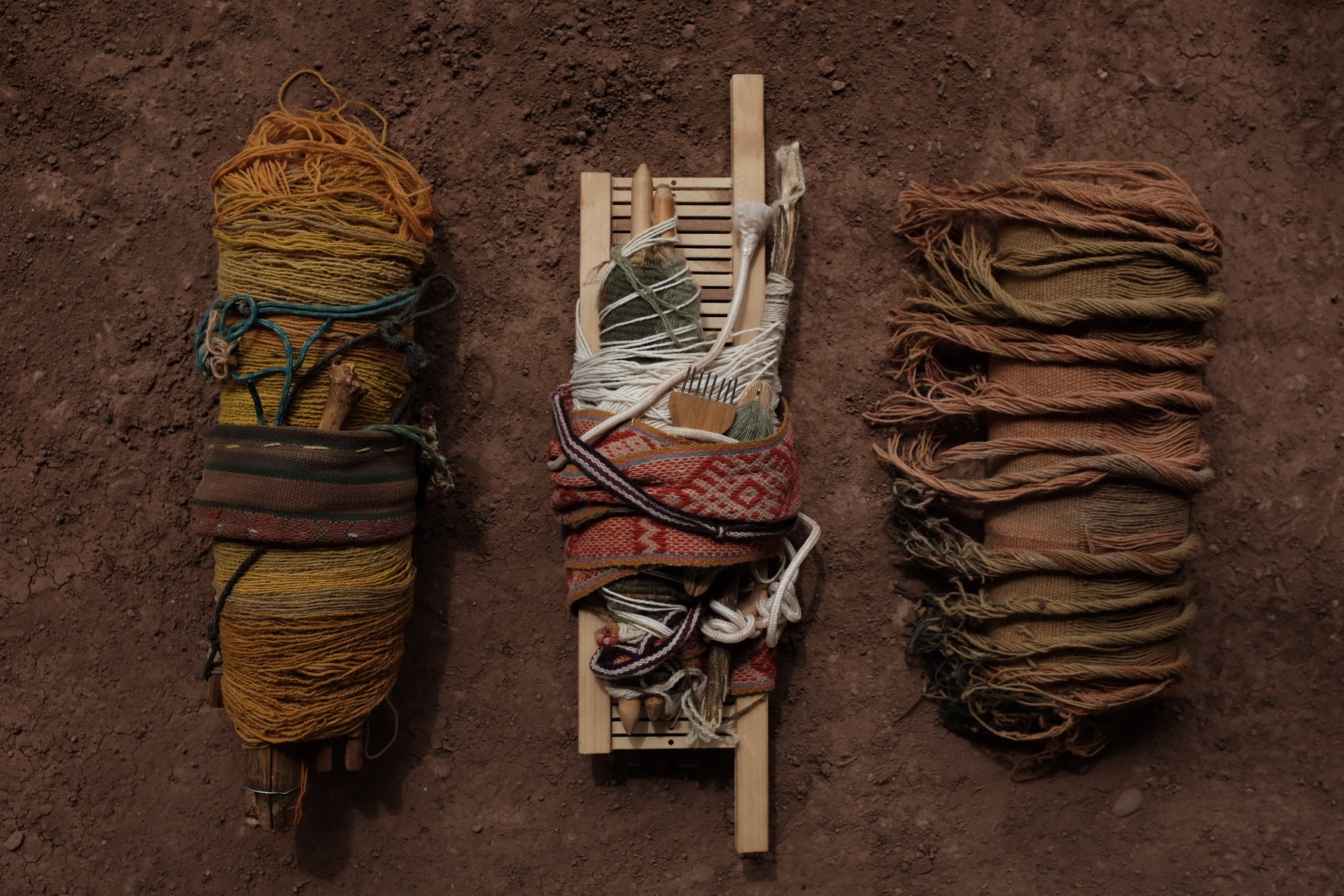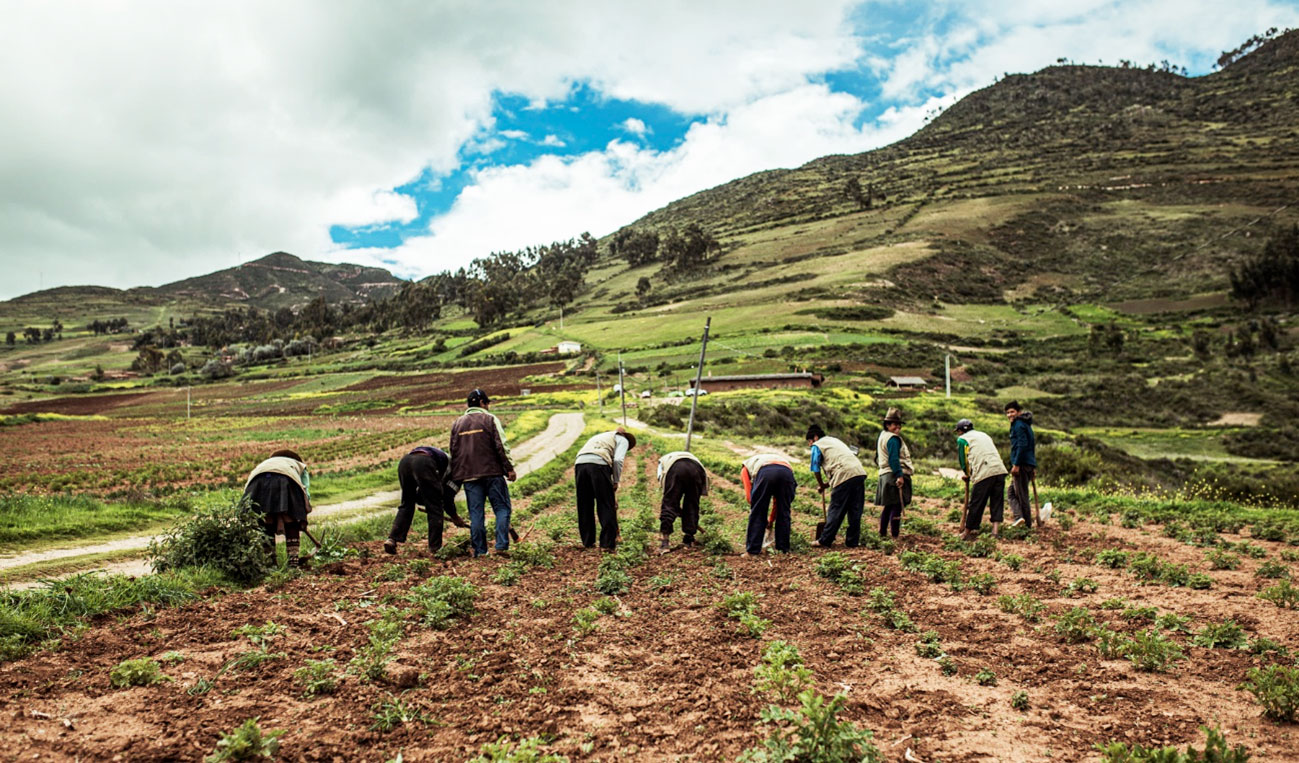Edible Synchronicities
Landscape relationships through colors
17/10/24
Gabriela Aquije
10 min

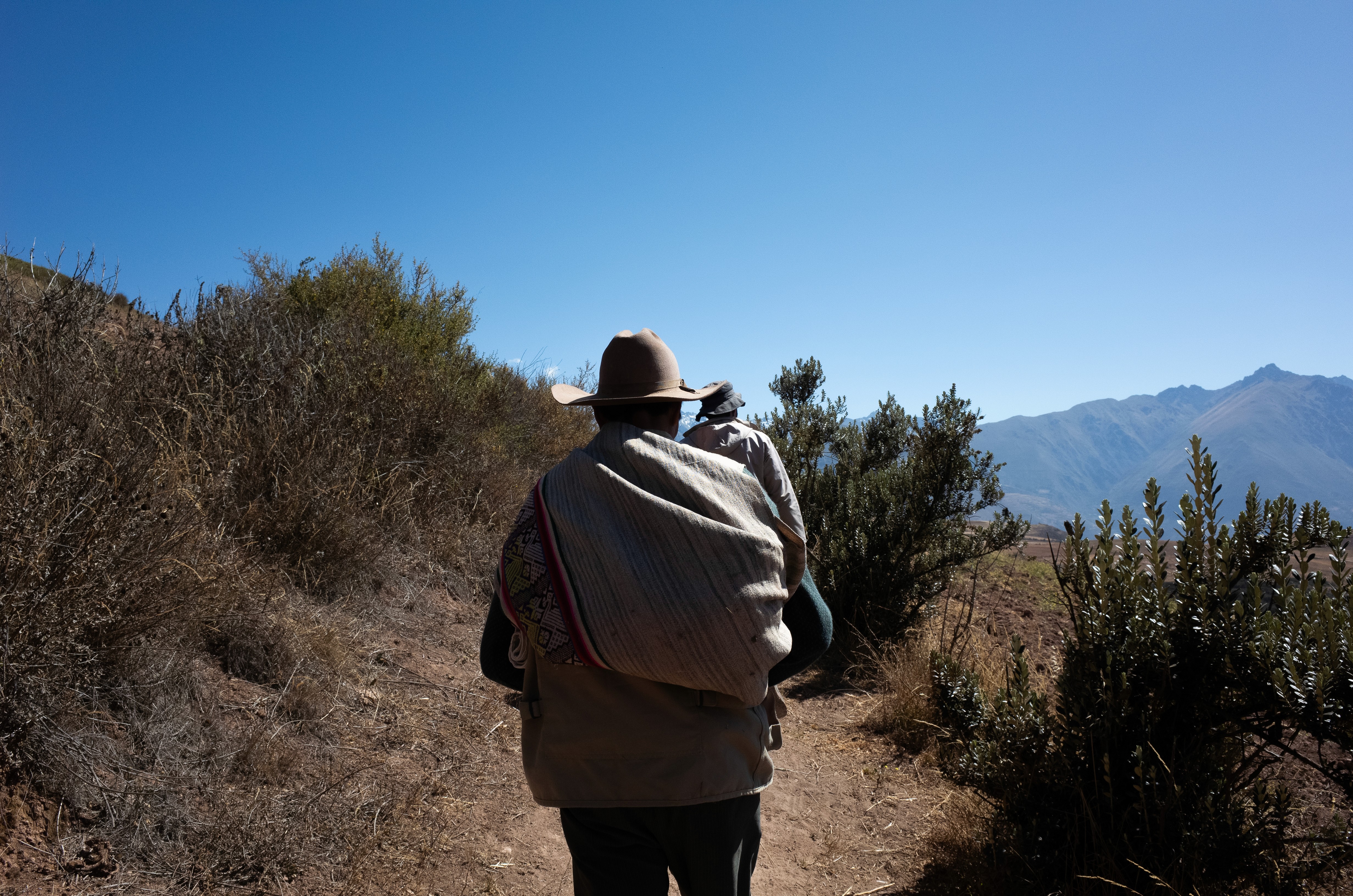
Immersion route with Cleto Cusipaucar and Jan Brack. Edible Synchronies (Cocinas Alterinas, 2023) Photo by Mayar El Bakry.
Hello reader!
We’re Cocinas Alterinas, Gabriela Aquije (PE/CH), and Mayar El Bakry (EG/CH), a critical design collective based in Switzerland (that operated between 2019 – 2024). In our practice, we researched kitchens as sites of care and creativity to make visible connections between communities and landscapes. As trained designers, we embraced the complexity of food practices while translating them into different mediation formats to dialogue with the people we investigate with.
Our collective practice was nurtured from our individual explorations, so based on previous relationships in the Sacred Valley of Cusco, we developed a project named Edible Synchronies. Thanks to the generous support of Pro Helvetia South America, the MATER artistic residency welcomed us last dry season (austral winter) of August 2023 to investigate the connections between humans and land through food-based practices.
Or, more precisely:
What are the hidden relationships between humans and the land that can be investigated through farming, foraging, and cooking practices?
This was an challenging research question, but we were excited about the entanglement between our creative practices and the andean landscape dynamics. So, during our four-week residency, we dove into the Andes dry season and learned from the skilled members and representatives from the research MATER labs (distillation, fermentation, and color atelier), the MIL restaurant kitchen and service, an extended network of artisans, producers and the agricultural local communities of Mullak’as Misminay and Kacllaraccay.
In our practice, we considered kitchens as potential workshops, both in the spatial and mediation sense —spaces for creation, reflection, and critical thinking. The different MATER/MIL areas and its kitchens offered us a context for experimenting at various scales, from markets to tables, and landscape altitudes and ecologies.
Day by day, we followed the lead of each expert and their practices: we listened, filmed, drew, walked uphill, recollected, harvested, discussed, noted down, walked downhill, registered, boiled, dyed, photographed, filtered, dried again, noted down again, walked, peeled, blend, cooked, served, eat, shared, gave thanks (to each other and the land) and a long list of etceteras. Learning by doing with each practice to explore, meditate, and (re)generate relationships along the research center and restaurant areas and landscape scales.
First color extraction experiments with the Warmis. Edible Synchronies (Cocinas Alterinas, 2023) Video by Mayar El Bakry.
Each team and space taught us a lesson:
The chacra (field) and MATER team helped us understand the important dynamics between community labor and reciprocity to the Pachamama (mother earth).
The liquids lab guided us through the biodiversity of medicinal plants finding a renewed value in the intersection of rooted ancestral and contemporary processes.
The Warmis atelier taught us about textiles and natural dyes, their varieties, mixtures, and cycles concerning the plants and produce available in the dry season.
The MIL kitchen team and service made visible the relations between gastronomy processes and traditional cooking methods, still respectful and innovative.
Various experiments emerged as we paid attention and exercised these lessons, between anthotype tests and botanical graphic installations. Finally, we translated three weeks of hands-on work and dialogues inside and outside the kitchens into two prototypes: a table map based on the ingredient’s mediation tool in MATER and a color calendar based on three extraction processes from the mentioned areas.

Mater table, after being rearranged. Edible Synchronies (Cocinas Alterinas, 2023) Photo by Mayar El Bakry.
As the prototypes evolved through the residency, we conducted around 20 interviews with different members of the MATER, MIL, and CENTRAL network, as well as local experts and dear mentors who met during previous fieldwork.
We wove the conversation with them through 5 questions that revolved around labor, land, seasons (time and climate), and flavor:
1. What prompted you to work as (job description)? Tell us an anecdote/memory of your first steps.
2. How did working as (description of your work) change your relationship with the territory and the communities (of producers and others)?
3. What is the role of the weather and the seasons in your work?
4. Have you noticed any significant changes in the environment you work in since you started?
5. Which flavor does transport you and where does it take you?
These interviews added a personal layer to the research scope but also portrayed and connected different joys and struggles across the territories we visited. While Mayar explored audiovisual and photographic portrayals, Gabriela dwelled in oral and drawing storytelling. Among various things that our creative processes unveiled, the topic of climate change was very present.
As the residency went by, we noticed that from different altitudes, stories, and perspectives, people shared how climate change has affected and has been experienced in their food practices and crafts. The climate emergency is an everyday reality for people in close relationship to the land, and became visible through these interviews, showing another side of collective endurance and creativity in the dry season.

Drawing interview with Solischa. Edible Synchronies (Cocinas Alterinas, 2023) Drawing by Gabriela Aquije
To complement expertise with lived experiences for this residency, we also trusted the guidance of four mentors from the region, indigenous Quechua and not. One of them, Soledad Secca (or Solischa, in her media channels) a proud Quechua woman and visual anthropologist from Occopata (Cusco), supported us during the second week of residency at MATER.
Thanks to Soledad’s expertise and fluency in quechua runasimi (her mother tongue), we’re able to have a translated and careful dialogue with the communities of Mullak’as Misminay and Kacllaraccay. As well, we valued her initiative to translate our final dinner invitation, from Spanish, and intuitively created a Quechua Runasimi audio recording, to ensure the clarity and accessibility of the invitation.
By the end of the residency, we organized “Del ayni a la mesa” (from ayni -or reciprocal labor- to the table) a collective meal and gathering, to give thanks for all the many exchanges and generous lessons we implemented along our residency. As a way to bridge across altitudes and set a meeting ground for all communities, we planned for this dinner to take place next to the Urubamba River in Ollantaytambo. For this, we trusted our other two mentors, Johanna Sarmiento and Antonio Sorrentino, who lead the (family) team of ALQA Museo de Arte y Cultura Andina.
While preparing for this dinner, we collaborated with our two other Indigenous Quechua masters: Mama Eusebia Silvia Tapia (Maras – Ollantaytambo) and Isaac Riquelme (Huilloc - Ollantaytambo) in ancestral cooking and fermentation methods. With Mama Eusebia we prepared a two-day and half chicha (fermented corn drink), trusting her to teach us not only the process but also the significance of hosting with chicha, the ancestral fermented maize drink. With Papa Isaac, we foresee the construction of the Pachamanca or earth kitchen, which served as a great teaching space and moment during the collective meal.
Del ayni a la mesa, collective dinner at ALQA museum. Edible Synchronies (Cocinas Alterinas, 2023) Video by Belami Cardenas.
This gathering was a celebration for and with the dry season. It was a joyful chaos that linked the steel and earth kitchens. We ideated recipes, cooked, ate, and cleaned collectively. That is what ayni means "hoy por ti mañana por mi" (today for you, tomorrow for me) since the Inca's time reciprocity is the currency for fostering economies and relationships. This dinner honored that principle. And, as learned on the Pachamama day, 1st of August, in our first week of residency: sharing in community is the best way to honor the land gifts.
In this residency, we expanded our perspective of what a food-based practice is thanks to the endurance, warmth, and adaptability of the people who live in close relationships with the Andean extreme landscape, and its cycles of abundance and scarcity. After these experiences, we felt deeply honored and connected to the stories we had the pleasure of listening to and the memories we could share.
It was an immersive learning experience.
Thank you so much!
Cocinas Alterinas
We wish to share the prototypes of the MATER TABLE and the COLOR MAP as manuals to pass on the joy of our experimentation process and foster the curiosity and re-enactment of each prototype into the next season. As well, we’re adding one interview drawing and a few quotes from one of our collaborators who generously guided us through each prototype.
Mater Table
The MESA MATER (mater table) is located inside the main research area and is central to the immersion route. Displayed on the table are all the different ingredients and natural elements that are part of the various recipes and processes from the MIL restaurant. The table functions as a display composed of roots, barks, seeds, leaves, flowers, fruits, and tubers gathered by the MATER research team and guided by the different members of the Mullak’as Misminay and Kacllaraccay communities, as well as the exploration routes and partner producers from the cloud forest of Cusco and the Amazon forest. These elements come from plural landscapes and altitudes, ranging from 0/850 - 5000 m.a.s.l (meters above sea level), and are constantly changing according to the season's availability. The proposed starting level could vary from 800 m.a.s.l for a MIL recollection and products, or 0 m.a.s.l for a CENTRAL products.
To understand this piece and optimize the table’s mediation potential we were in conversation with Jan Brack, Manuel Contreras, Cleto Cusipaucar, and Agnes Rivera -among other members of the MATER research team and neighbor communities

MATER TABLE MAP, axis and areas graphic. Edible Synchronies (Cocinas Alterinas, 2023) Graphic by Cocinas Alterinas.
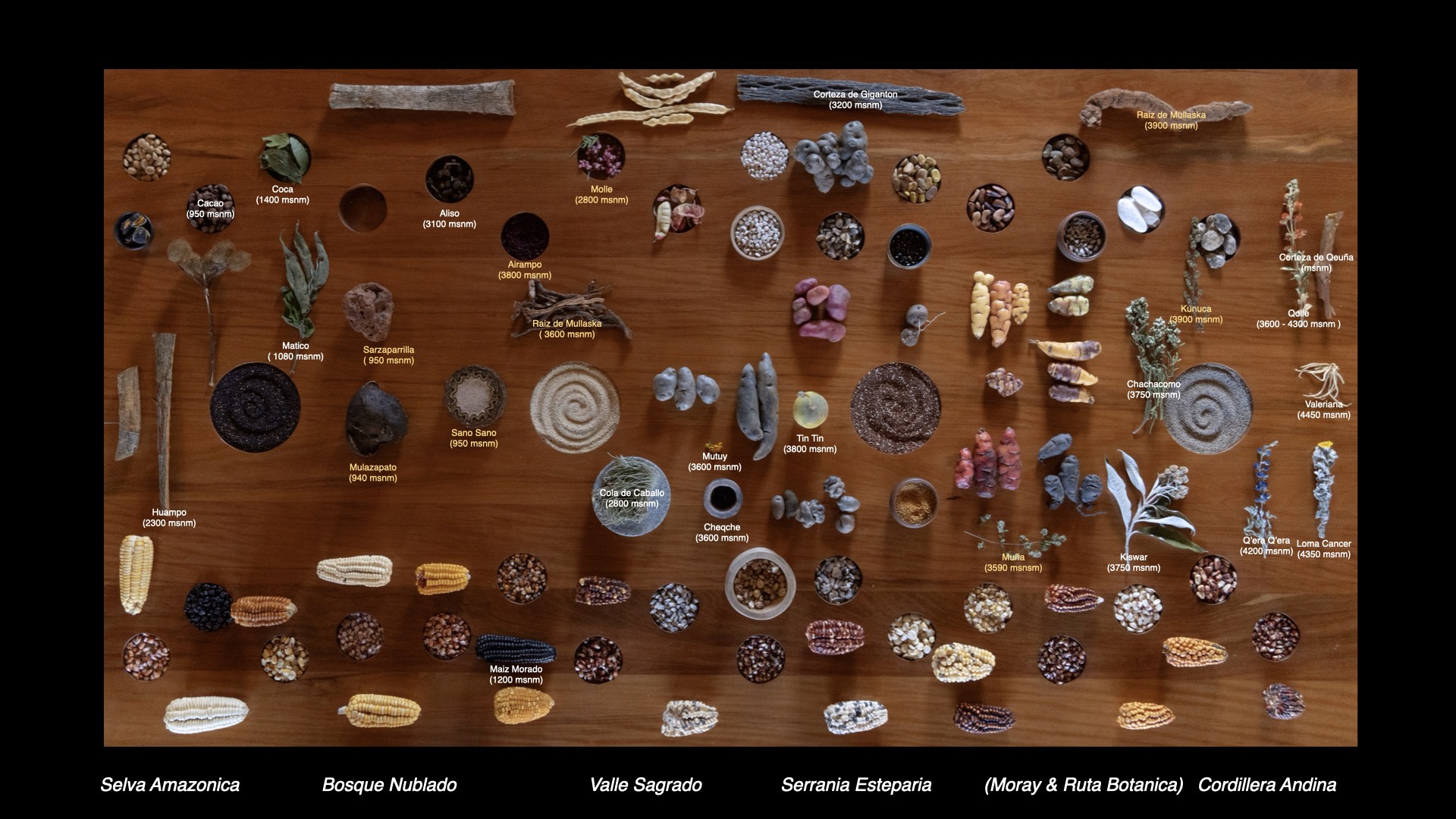
MATER table organized according to height and humidity levels, in conversation with Jan Brack and Manuel Contreras. Edible Synchronies (Cocinas Alterinas, 2023) Photo by Mayar El Bakry.
Description of the prototype:
The display was rearranged into two axes, altitude, and humidity, and three main landscape zones: rainforest, altitude valley, and Andes mountain range. Then, each botanical element was placed at the intersection of these three values, except for the maiz, which lay on the bottom area only arranged by altitude.
The aim was to provide a base and coherent structure in which each element reveals the characteristics of its landscape of origin. This allowed both the research team and the guests to read the table as a cartography of the restaurant ingredients and their connected values.
This prototype also serves as a calendar. It showcases the diversity of the seasons, allowing the team to update and change elements on the table according to each season.
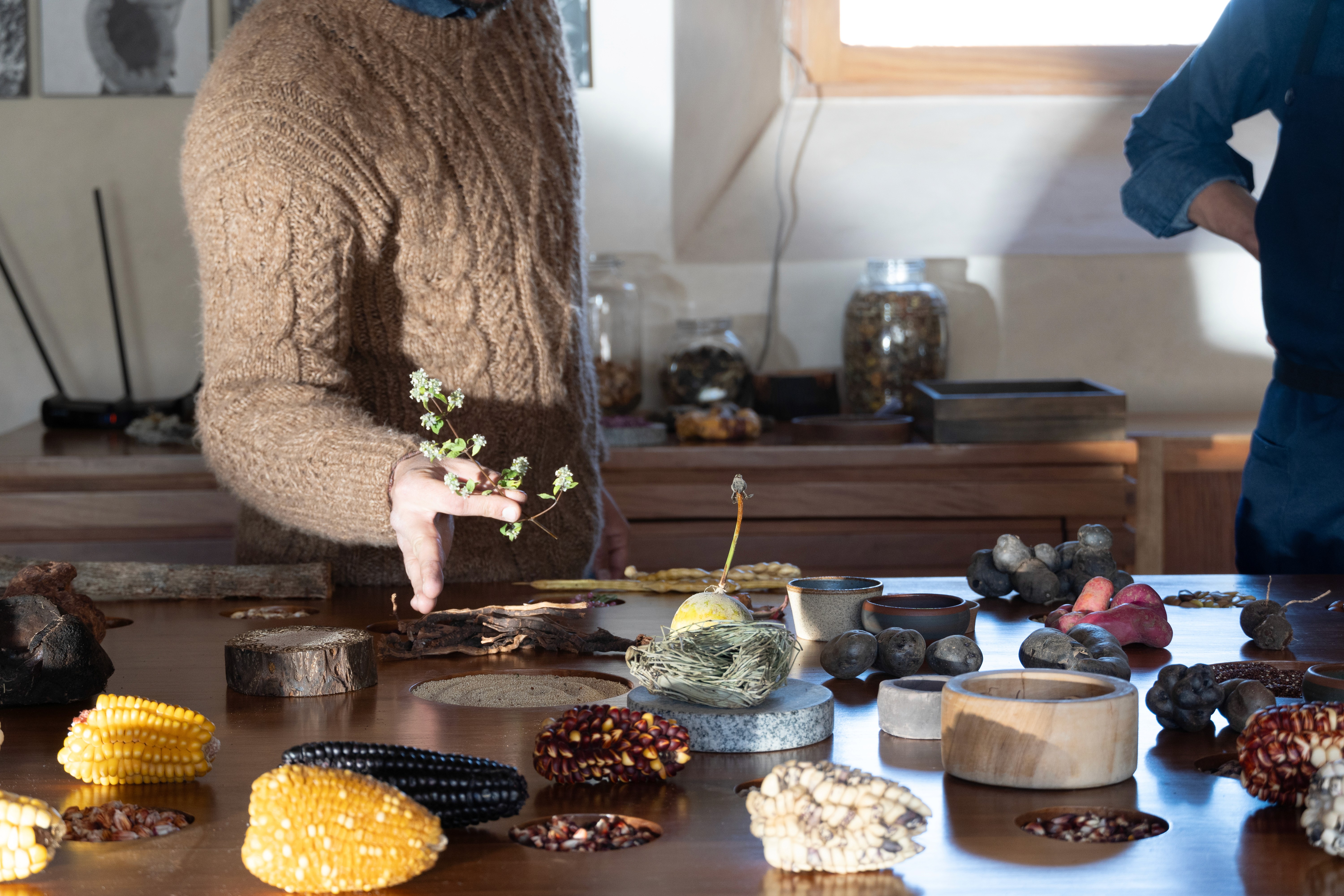
Mater table work in process with Jan Brack and Manuel Contreras. Edible Synchronies (Cocinas Alterinas, 2023) Photo by Mayar El Bakry.
Use:
Define the axis of altitude and humidity through the longitude and width of the table
Divide the extension of the table into three main areas according to their ecosystem (and optional two more): amazon forest (rain and cloud forest), sacred valley (steppe highlands), and Andean mountain range.
For the previous two steps, you could use a thread, masking tape, or any marker so as not to lose an overview of the axis and areas.
Arrange each element/ingredient on the table surface according to the place corresponding to its altitude, humidity, and landscape ecosystem values.
Replace and repeat this process with each season change
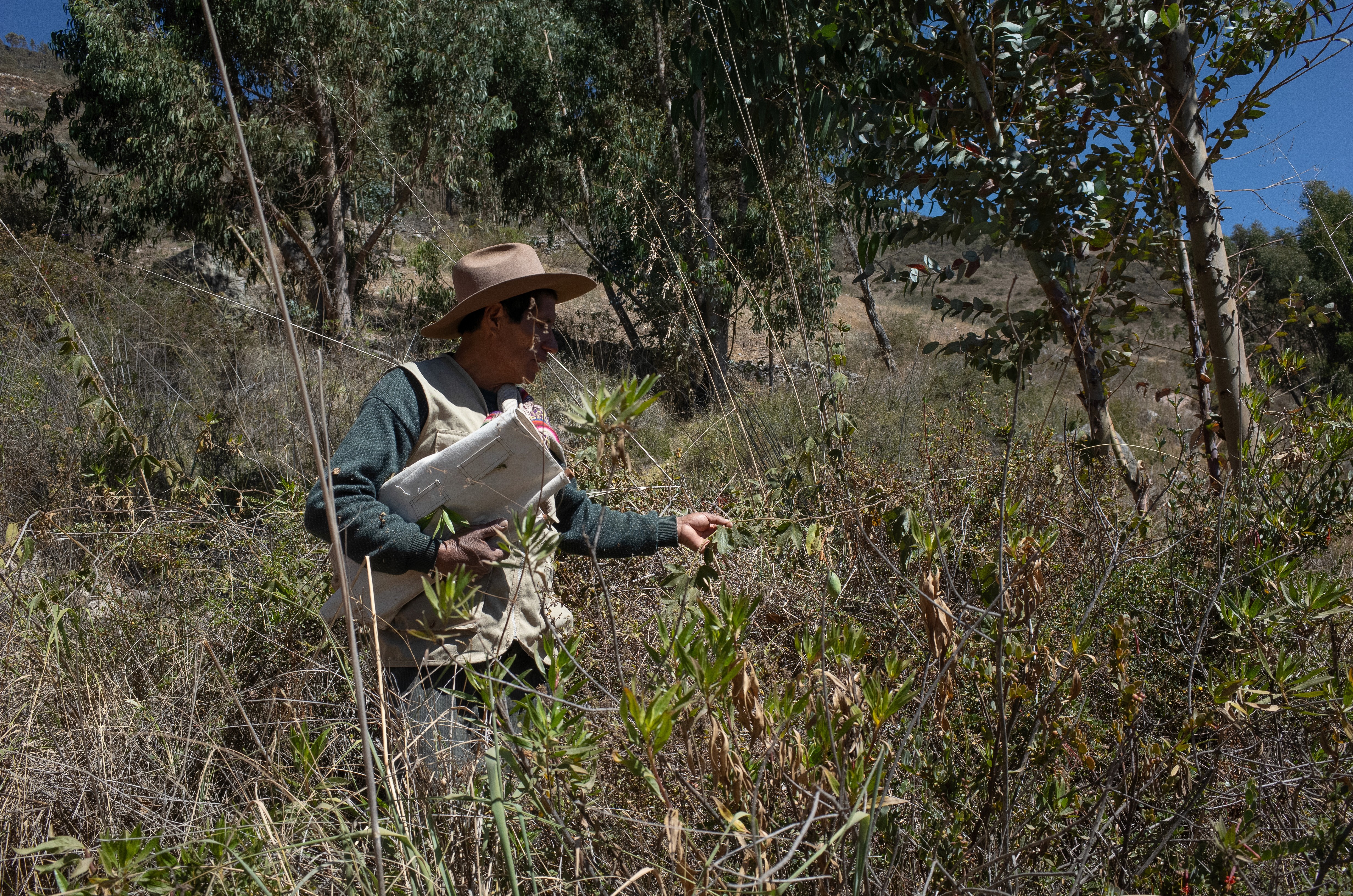
Papa Cleto in botanical recollection. Edible Synchronies (Cocinas Alterinas, 2023) Photo by Mayar El Bakry.
Cleto Cusipaucar
“Es importante recordar las plantas del lugar, sus nombres y su valor. Todo lo que sabemos lo compartimos oralmente.”
"It is important to remember the local plants, their names and their value. Everything we know we share orally."
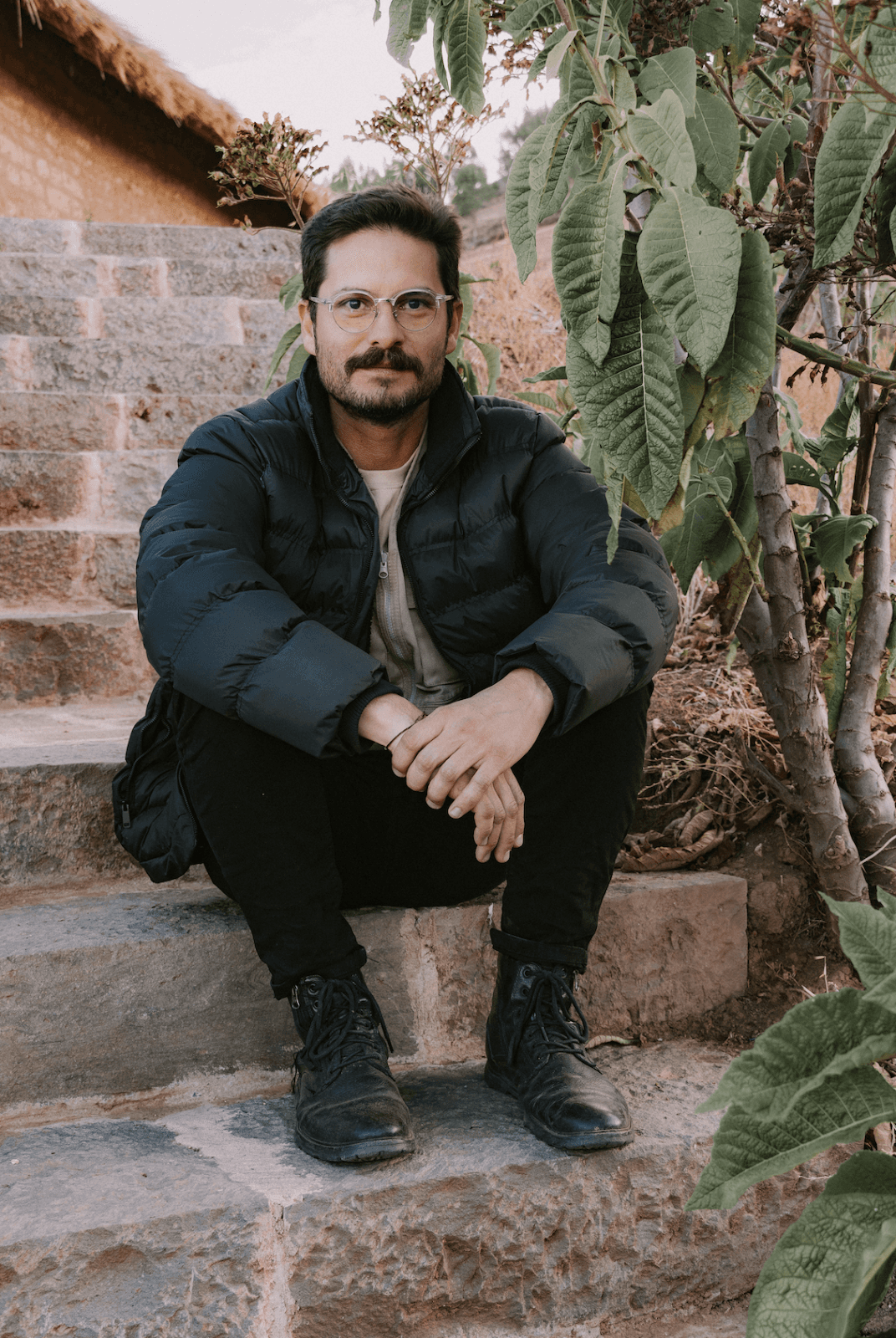
Jan Brack and his favourite spot next to the Tabaco plant. Edible Synchronies (Cocinas Alterinas, 2023) Photo by Mayar El Bakry.
Jan Brack
“Cada persona es un agente de cambio donde este (...) La gastronomía nos une en el entendimiento con la naturaleza”
“Every person, from where they are, is an agent of change (...) gastronomy reunites us in understanding nature”.
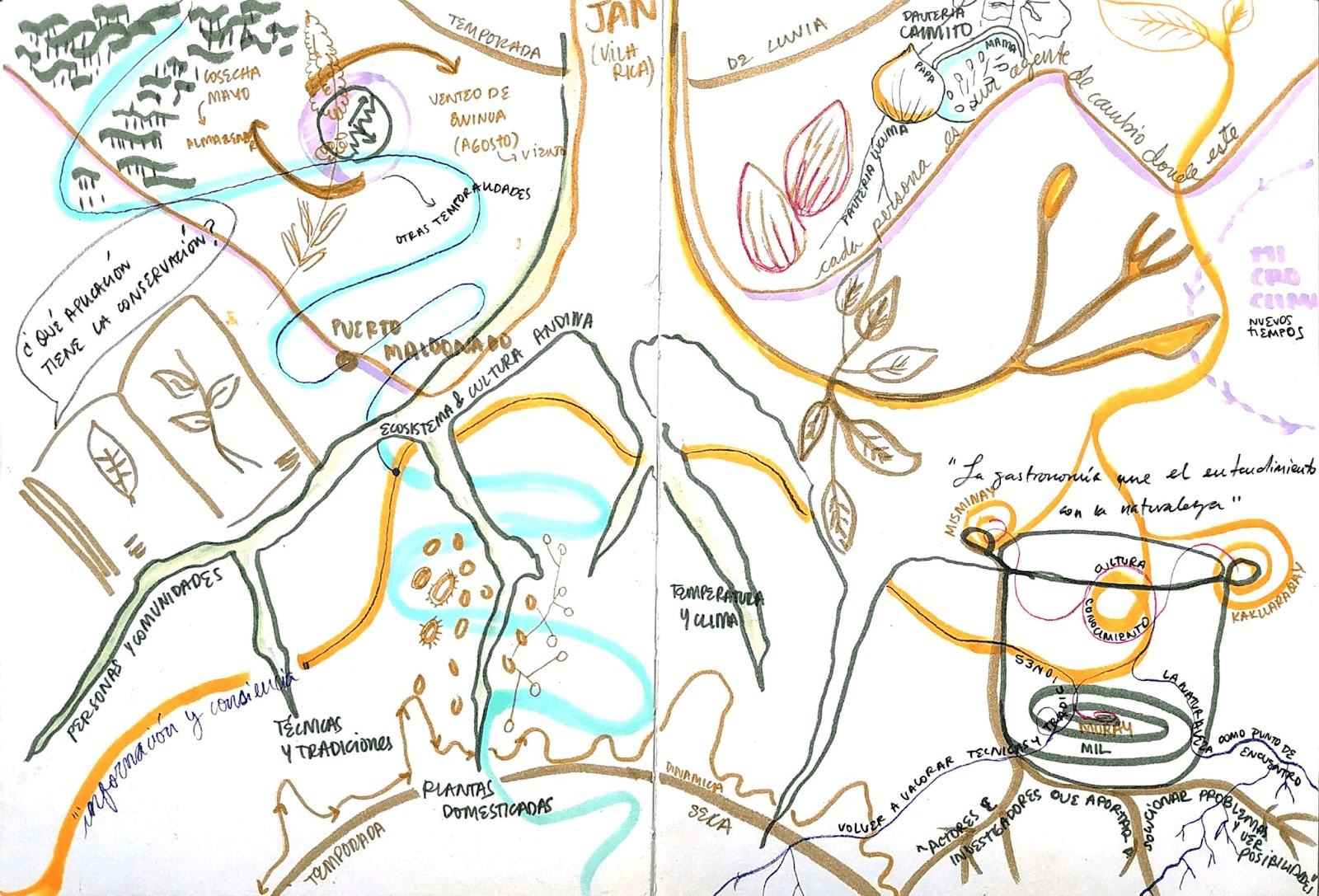
Jan Brack's interview drawing. Edible Synchronies (Cocinas Alterinas, 2023) Drawing by Gabriela Aquije Zegarra
Color Map
The color map emerged after the experience with the MESA MATER prototype and through different experiments and dialogues with the Warmis color atelier (taller), the liquids lab, and the MIL kitchen.
While mapping the table cartography's different elements, we spotted that botanicals were a common thread throughout landscape ecosystems. In response to our research question, this prototype visualizes the different botanicals/ingredients of the dry season and their uses in three different areas/kitchens through their color-extraction processes.


COLOR MAP, landscape axis, and double areas graphic. Edible Synchronies (Cocinas Alterinas, 2023) Graphic by Cocinas Alterinas.
Color extraction at the Liquids Lab. Edible Synchronies (Cocinas Alterinas, 2023) Video by Mayar El Bakry.
Description of the prototype:
To develop the prototype, we decided to use only available material in the valley area and already used in MATER/MIL spaces. Thus, we collected most of the color samples with both tocuyo cloth (similar to canvas) and filtered the sediments with kitchen paper, storing them in glass jars from the fermentation lab.
The prototype was developed over a rectangular tocuyo cloth, divided into two sections with one common altitude axis, like the MATER table. On one side, the display arranged the color sediment samples along the three different spaces and processes of extraction: traditional (k’oncha, stove in Quechua runasimi) color extraction, distillation and fermentation processes, and cooking dyeing experiments. Conversely, the taint samples responded to different parts of the botanicals: seeds, roots, barks, fruits, flowers, and leaves.
This Color map combined this information and proposed a visual composition relating landscape altitudes to the dry season's processes and textures. To craft this piece, we were in dialogue with the Warmis from Kacllaraccay (Mama Purificación Aguilar, Mama Yolanda Atau, Mama Inés Challco, Mama Ceferina Atau, Mama Modesta Saloma, Mama Leonarda Meza, Mama Inocencia Challco), Manuel Contreras, Jean Pierre Diaz, Jan Brack, Juan Jose Bueno Alvarez, Aida Miranda, Luis Valderrama, Andrea Faour and Veronica Gamarra.
Materials:
Tocuyo cloth (as much as available)
Wipe or kitchen washable paper (white) – better that is water resistant
Transparent glasses 50 ml (approx) – preferably wide mouth
Rubber bands or thread
Markers and etiquetes
Spoon or paleta
Food dying with huacatay, at the MIL kitchen. Edible Synchronies (Cocinas Alterinas, 2023) Video by Mayar El Bakry.
Use:
Sediment samples
Set up the transparent glasses (wash and dry) plus small squares (subdividing x3) of kitchen paper. put this paper on top of the mouth of the glass and push gently to create a concave surface (space for filtration) then fix this with the rubber band.
Along a week, take as many samples (around 50 – 100 ml) as possible from the Warmis workshop, liquids laboratory, and MIL kitchen, focusing on the Botanics. Mark each one with a code of the area it came from and a number to refer to the name of the botanic; specify which part did you used (root, flower, stamp, leaves) if it was dry or freshly picked.
For taking the sample, grab a measuring cup (or any cup) and slowly pour through the cloth into the glass. Be careful not to overflow the top, as depending on the part of the botanical and process, the sediment/pulp will be ticker. If this is too thick to continue with the filtration, replace the paper cloth with a new one and continue the process.
For the kitchen and the liquids lab, take note of the process and additional materials that were added to the botanical.
For the warmis workshop, take samples with the fixer (mordiente) and without it, and note down the boiling period time of the extraction. Try to get one at 30 min, 60 min and by the end of the taint process -then is where most of the sediment will be at the bottom.
After all the liquid taint is through the cloth, let it hang for around 15 – 20 min to release the last drop of water. Then remove the cloth and extend it gently to, careful not to break it or drop the sediment, fix the four corners of the cloth with weight so it doesn’t shirk.
Label the bottle with the color liquid accordingly and place a small label in the corner top of the sediment cloth with the code of the area and number of the liquid sampled.
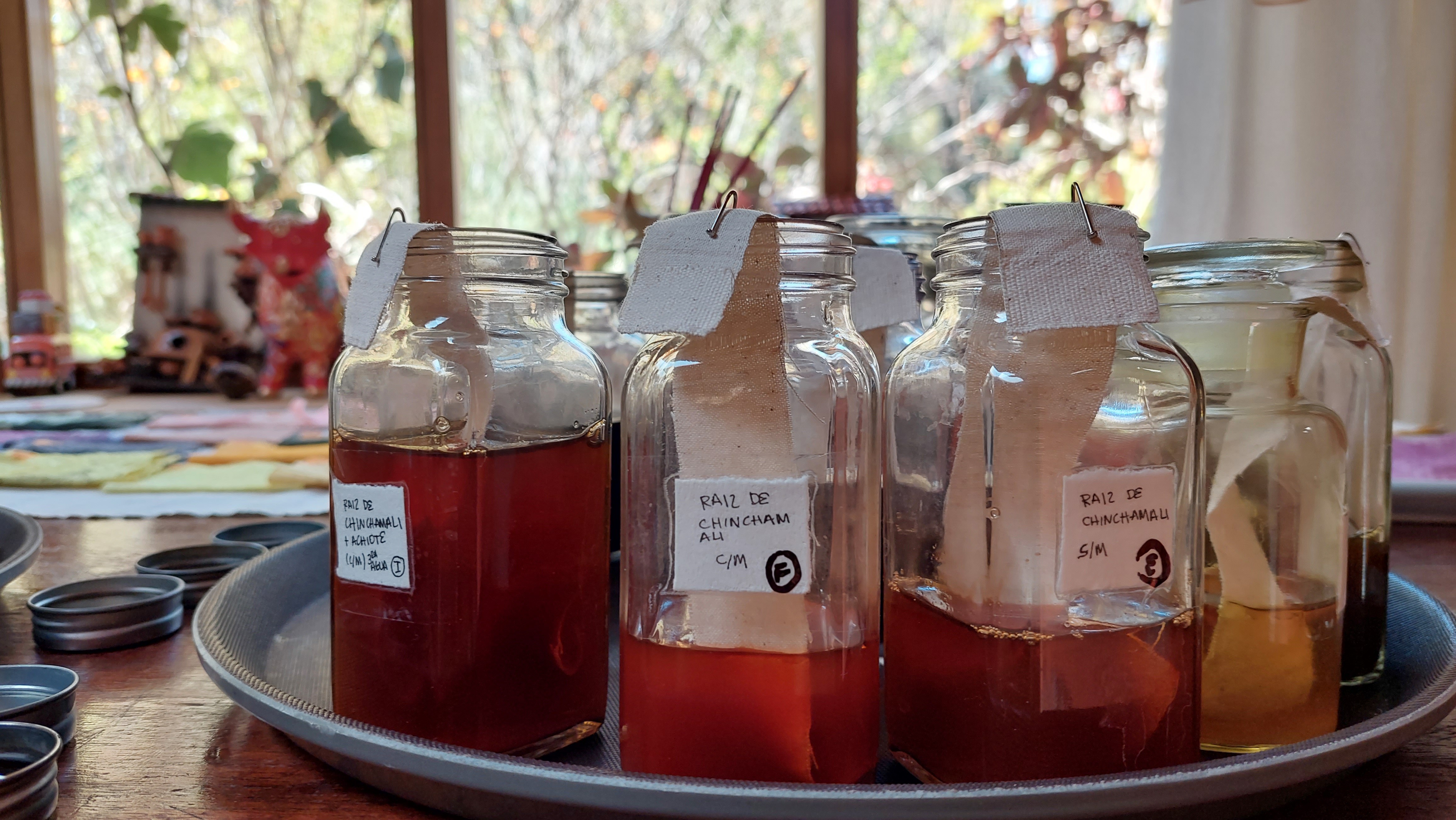
Color samples for the mapping prototype. Edible Synchronies (Cocinas Alterinas, 2023) Photo by Gabriela Aquije Zegarra.
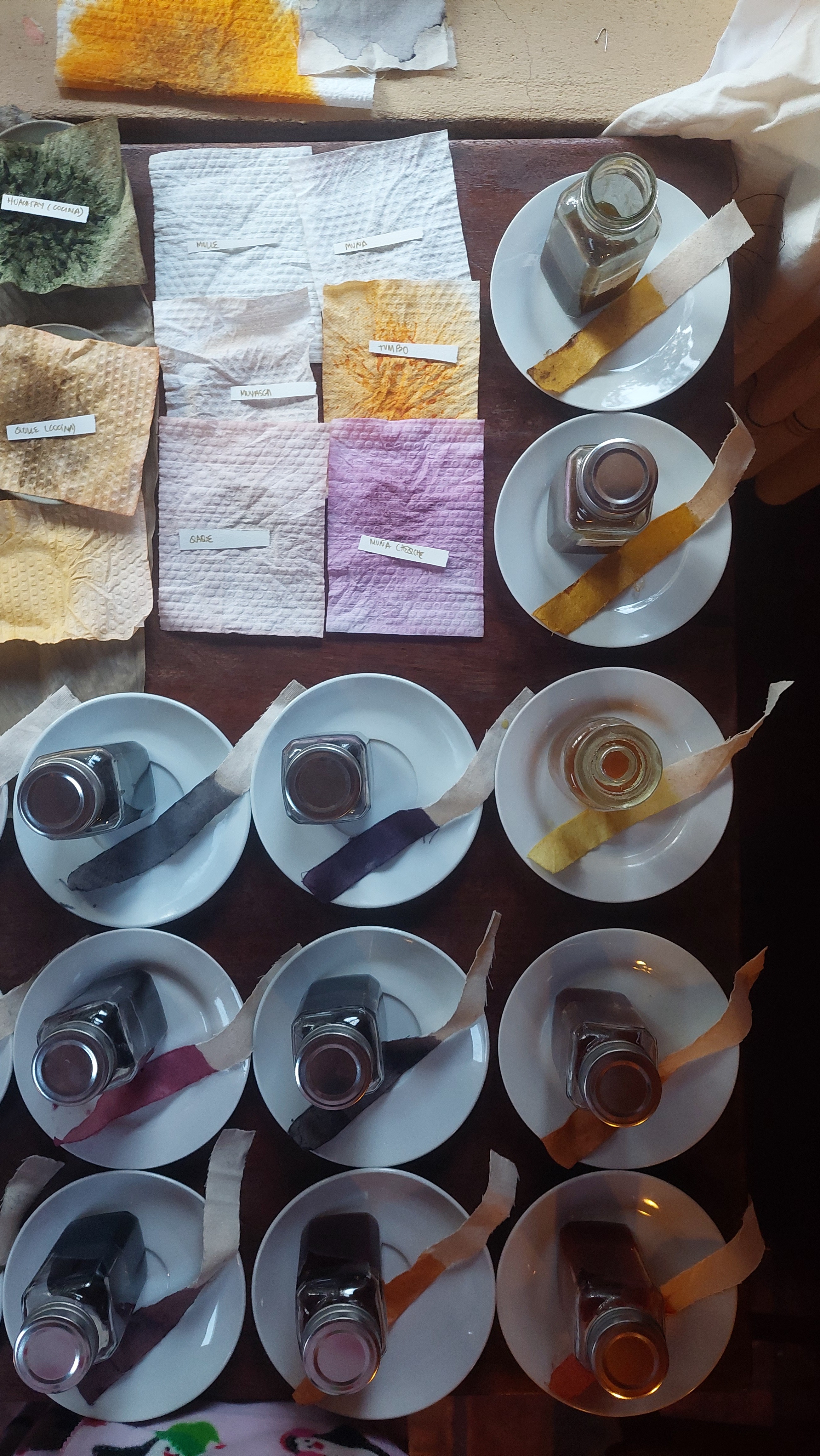
Color and sediment samples. Edible Synchronies (Cocinas Alterinas, 2023) Photo by Gabriela Aquije Zegarra.
Color samples
Cut longitudinal tocuyo cloth stripes of around 50 cm x 20 cm (approx.) one per color sample, then place one per glass and leave them overnight.
Let them dry and then press them for a day long with something heavy (book or otherwise) so the tocuyo doesn’t wrinkle
Mark the altitudes of the ingredients, if there are many choose the average one.
Map
Go through the MATER table and find the botanicals from the colors you sampled. Note down their altitude.
Cut a rectangular piece of tocuyo cloth, with a length that is double or triple the measure of the width. Eg.: 80 x 140 cm or 160. Along the width mark the lowest and highest altitudes from the identified botanicals, and then subdivide this every 500 m (suggested). Then divide the tocuyo length into two, marking the three areas on one side and the parts of the botanicals on the other (see graphic below).
Suggestion: The final length will depend on how many samples you’ve collected, so try mocking up this first arrangement with a pencil and then cutting the tocuyo to avoid material waste.Following the altitude axis, the area and botanical part organize the samples accordingly. Pin them with a needle, trying to leave space to read the information in each stripe.

COLOR MAP, first prototype. Edible Synchronies (Cocinas Alterinas, 2023) Photo by Mayar El Bakry.
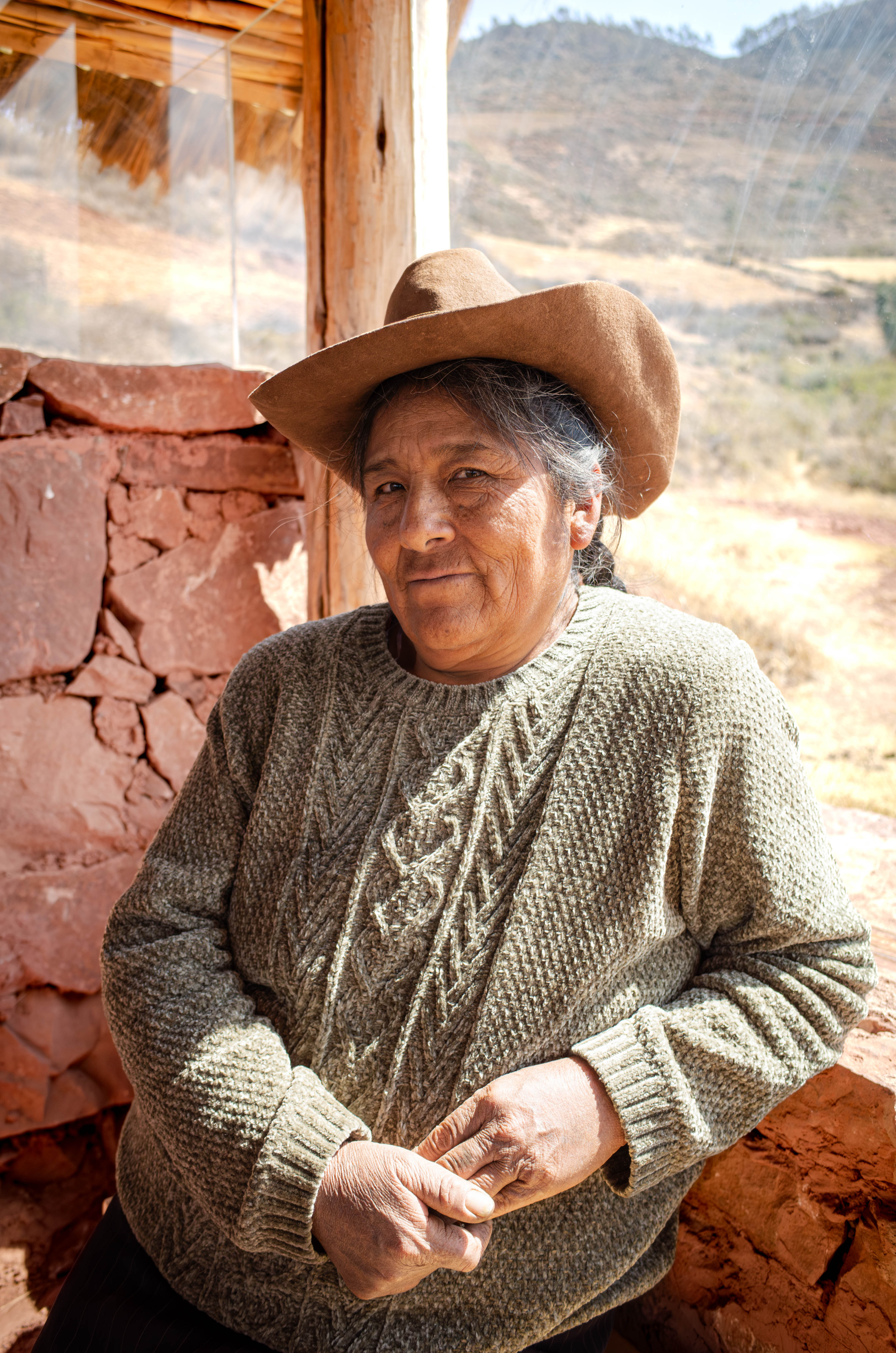
Mama Inocencia Chalco, in her atelier. Edible Synchronies (Cocinas Alterinas, 2023) Photo by Mayar El Bakry.
Mama Inocencia Chalco - WARMIS Aterlier
“Para respetar la tecnica ancestral warmi de tintes naturales tenemos diferentes variedades de recoleccion que cambian de temporada de lluvia a temporada seca.”
"To respect the ancestral warmi’s technique of natural dyes we have different varieties of collection that change from rainy season to dry season".
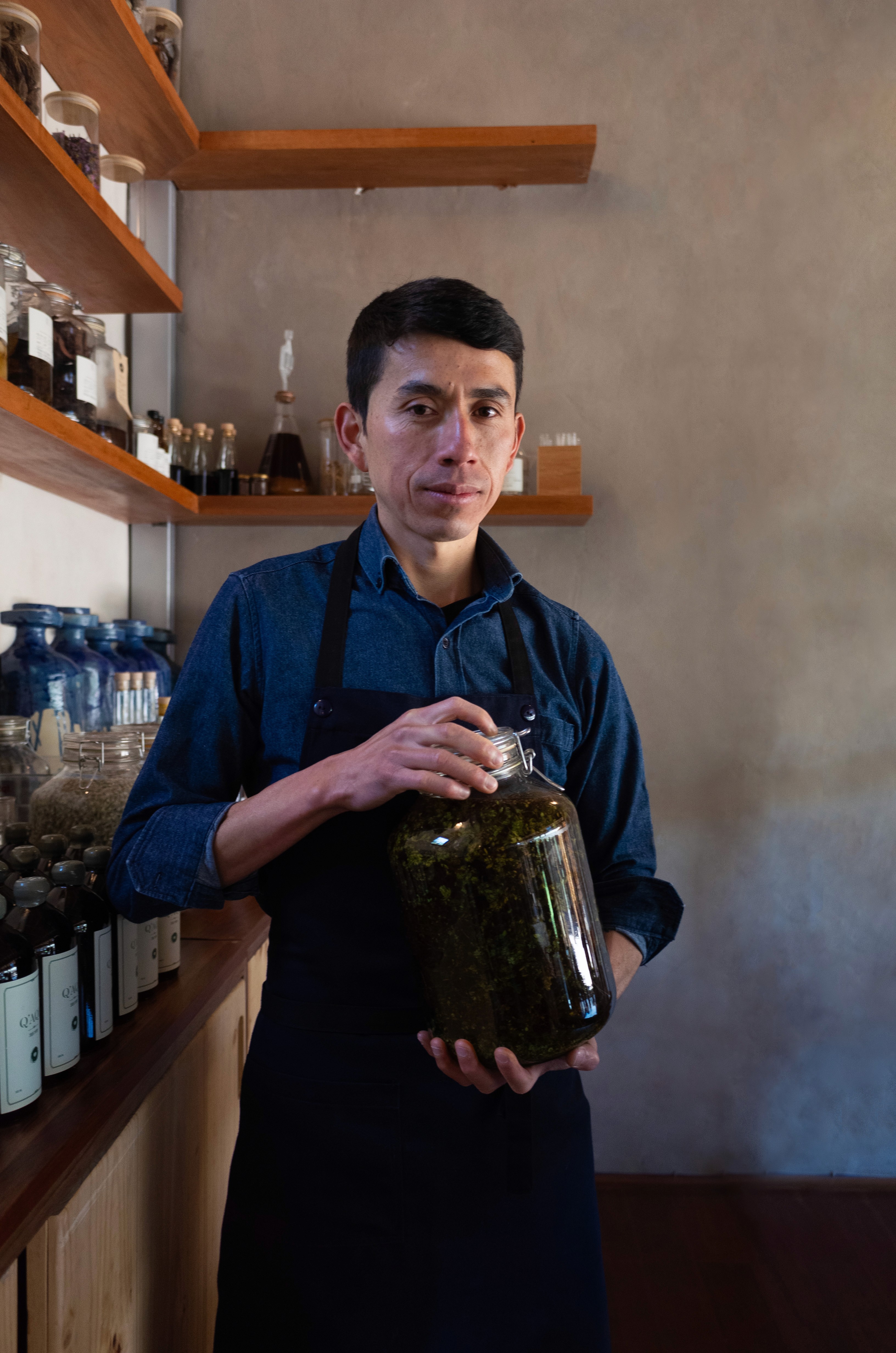
Manuel Contreras, in the liquids lab. Edible Synchronies (Cocinas Alterinas, 2023) Photo by Mayar El Bakry.
Manuel Contreras - MATER Liquids Lab
“A mayor altura, tanto las personas como las plantas, tienen mayor fortaleza (...) lo nuestro es una labor con respeto al origen.”
“The higher the altitude, both people and plants have greater resilience (...) what we do is a labor respectful of the origin.”

Manuel Contrera’s drawing interview. Edible Synchronies (Cocinas Alterinas, 2023) Drawing by Gabriela Aquije Zegarra
Credits:
Edible synchronies (2023 - 2024), project and concept development by Cocinas Alterinas, Gabriela Aquije Zegarra and Mayar El Bakry.
Text, drawings, and manual storytelling by Gabriela Aquije Zegarra
Copyediting, photography, and video documentation by Mayar
El Bakry
· Photos, drawings, and graphics credits are specified in each caption.
· All knowledges portrayed in the pictures, videos and drawings are from the persons we exchanged with: MATER, MIL, Central, Misminay & Kacllaraccay communities.

